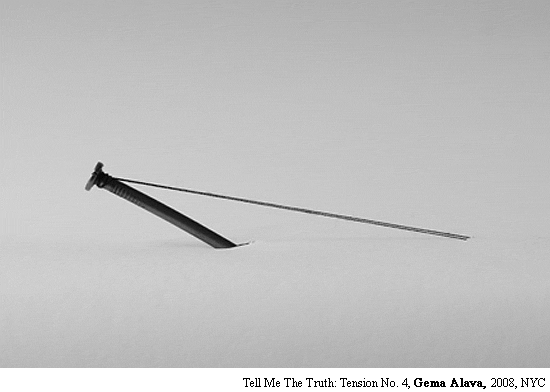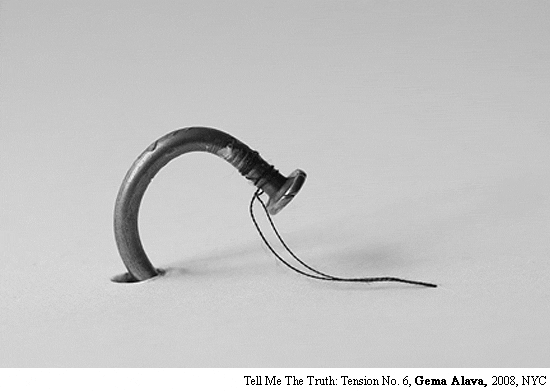Previous Post Next Post
Wednesday, April 2nd, 2008
Gema Alava: “Tell Me the Truth”
at Messineo / Wyman


! Extended to May 2 !
March 20 –April 26, 2008
Messineo Art Projects and Wyman Contemporary
227 West 29th Street, 4th Floor (# 111)
New York, New York
at Messineo / Wyman


! Extended to May 2 !
March 20 –
Messineo Art Projects and Wyman Contemporary
227 West 29th Street, 4th Floor (# 111)
New York, New York
by Ted Mooney
The truth is a hard apple, whether thrown or caught, as this young Spanish artist clearly knows. She tends, at her best, to think three or four moves ahead of her work’s viewers-not out of disdain for them or out of personal elusiveness, but simply to allow herself room to adjust her own thinking in relation to the effect her imagery has on her (rapidly growing) audience. One even gets the sense that these adjustments are what she’s most interested in. And that, if correct, is promising news indeed.
Alava’s most recent show, thoughtfully installed in Messineo / Wyman’s tiny 29th Street space, is breathtakingly elegant, deftly using the gallery’s space limitations to the works’ advantage. On exhibition are nine black-and-white silver gelatin digital photographs, printed on fiber paper and individually framed in white maple. Each work depicts, toward the left side of the print, a nail of indeterminate size-no scale is established in these works-protruding from a light gray, almost bluish ground that subsumes both foreground and background. Meanwhile, toward the right side of each print, emerging from a hole in this same placeless gray-blue void, are a few black threads, which seem to have ventured out along the ground to wrap themselves around the nail at midpoint or higher in what appears to be an attempt to uproot it from the security of its hole. A struggle, then-and so, inevitably, the appearance of a narrative. Each print shows the two elements-nail and thread-in a different state of dominance or submission relative to one another. At times the nail leans rigidly away from the threads, drawing them so taut they seem to fray almost to the breaking point. At others, the threads, exerting no less force, bend the nail savagely toward them, flexing it and nearly extracting it from its stubbornly held position. Occasionally, the two forces reach an equilibrium, though whether in exhaustion, momentary truce or even a hard-won peace, it’s hard to say.
At least on first encounter, it would be all but impossible for the viewer not to see in this struggle, which is presented to us as if on a completely featureless proscenium stage, the successive seasons in an emotional, probably romantic, human relationship. It could even, if the “time” interval between prints is imagined to be much shorter, be thought of as depicting various moments in a single act of lovemaking. The nail is undeniably phallic, the threads undeniably tactical in their approach and adaptive in their manner of struggle, almost certainly feminine. But no sooner has the viewer hit upon this fairly obvious thought-one even the most completely unreconstructed, frankly fanatical formalist would be hard-pressed to deny-than other, totally different questions begin to bubble up, one after another, in almost alarming profusion.
These questions begin with purely pragmatic speculations as to how these scenarios were physically created. The background suggests a space that is either infinite or non-existent, and, like someone who has just witnessed a magic trick, the viewer is seduced into trying to figure out how this effect was accomplished. Whether one arrives at a satisfactory answer or not, these speculations segue very quickly into the oddly threatening realization that there are absolutely no clues as to what the scale here might be. The force of the depicted struggle (as well as the size of the rather large, horizontally formatted prints) makes it hard not to succumb to the illusion that the stature of the protagonists-nail and thread-is equally epic. And yet when was the last time you saw a ten-foot nail? By now the sense that you are being manipulated is so strong that you begin to question everything. Where exactly can the physical tableaux that appear in the photographs be found? Why aren’t you being shown them, instead of what suddenly seems like photo-documentation of the real works, which are being denied you? Did the “true” art work somehow slip away between its physical embodiment and the trace of it preserved in the photograph? Or is the photo itself the art work?
And if these simple physical matters cannot be pinned down, then what about your earlier snap-judgment-strongly reinforced by the linear, apparently sequential installation of the photographs-that together they constitute a definite narrative, from image one to image nine (“The End,” as it were). Could the photos be resequenced so as to make a different “story”? Is the story you take from the photos really there, or is it a story you make from them because that’s the story you know: your story. Naturally, you then try looking at the prints in different orders to determine the possibilities. And so, by degrees, and quite unexpectedly, you find yourself stranded on a sparsely populated plain in the land of Beckett-or, more befittingly, given the artist’s Spanish background, that of Salvador Dali. (Note the Dali-esque shadows cast by the nail.) The seamlessness with which you have been transported from an almost cartoonishly amusing allegory of human relations to a place where some of the darkest fears and needs of the human heart are enacted-enacted and reenacted over and over again unto death-suggests that the artist’s intentions were, just possibly, not quite as innocent as you may have assumed. What you still have left to go on, however, is the title of the show: “Tell Me the Truth.”
To ask someone to tell you the truth-not a truth but the truth-is to instantly vaporize for good the very object of your request, the one that was so comfortably within your reach until you opened your mouth. Now the possibility of knowing the truth you asked for is forever denied you, because it died the moment you expressed your desire to hear it. This is something all unfaithful lovers know. And, however much we might wish it otherwise, when it comes to the truth, we are all of us unfaithful lovers.
Gema Alava’s work carries an uncanny power whose sourc
e lies precisely in how lightly she offers it. Often made from the humblest of materials, her art nevertheless gives off just the faintest trace of intense and prolonged concentration. Modest in scale, frequently fragile, it makes you think not of modesty or fragility but of resistance and struggle, life and death, the largest matters. Alava has a gift for effortless reversals that she does not hesitate to use in making her mortal point. And that point, more often than not, has to do with the universality of human suffering-cast by her, at times, in a Spanish key, for Spain’s suffering at the hands of history is well known. But the artist is under no illusion: such suffering is a condition of life, not of nationality.
Alava’s show remains open until April 26. See it now, before she becomes too well known for her work to be shown again in such intimate quarters.
Author: Ted Mooney is a senior editor at Art in America and the author of four award-winning novels. His most recent, forthcoming in early 2009, is titled The Same River Twice.
copyright (c) 2008 by Ted Mooney
Artist: Gema Alava born Madrid, 1973. MFA San Francisco Art Institute, 2000. Her work has been shown at The Bronx Museum of the Arts, The Queens Museum of Art and, thanks to the generous collaboration of Cai Guo-Quiang, her latest art project took place at the Guggenheim Museum, New York, February 21st 2008.